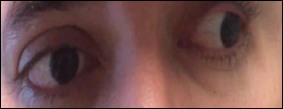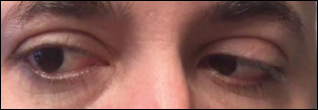Man presents with diplopia and ptosis of left eye
Three months prior, the patient experienced a similar incident that resolved within days.
A 36-year-old Hispanic man with no significant medical or ocular history was referred to the Tufts New England Eye Center with complaints of double vision and drooping of his left upper eyelid. Three months before presentation, he presented to an outside emergency department with complaints of sudden onset dizziness and double vision. He did not recall any other symptoms at that time. Workup was pursued at the outside hospital; Lyme titer, TSH, acetylcholine receptor antibodies, CT and MRI of the brain, and lumbar puncture were all normal or negative. His symptoms subsequently resolved within a few days, and no further investigation was pursued.
Three months later, he again developed vertical binocular double vision and drooping of his left upper eyelid. He noted his symptoms fluctuated and worsened as the day progressed. He presented to a local optometrist who then referred him to the Tufts New England Eye Center.
Examination
Upon examination at Tufts, the patient’s best corrected visual acuity was 20/20 bilaterally. Pupils were equally round and reactive with no relative afferent pupillary defect in either eye. IOP was within normal limits. Cranial nerves V, VII, VIII, X, XI and XII were intact bilaterally. Partial ptosis of the left upper eyelid was noted (Figure 1), and when the eyelid was lifted manually, ptosis of the right upper eyelid became apparent (Figure 2), demonstrating Hering’s law. Extraocular muscle motility exam revealed abduction and adduction deficits in the right eye (Figures 3 and 4) as well as an elevation deficit of the left eye (Figure 5). Saccadic intrusions were noted in the left eye. Exam was negative for lagophthalmos or lid lag. Slit lamp and dilated funduscopic examinations were otherwise normal bilaterally.





Images: Dajani OAW, Vuong LN
What is your diagnosis?
See answer on next page.
Diplopia and ptosis
Diplopia and limitation of extraocular movements involving multiple extraocular muscles can occur from compressive lesions involving multiple cranial nerves, neuromuscular diseases, thyroid eye disease and many other etiologies. First and foremost, a cavernous sinus lesion must be considered in a patient presenting with symptoms that appear to be affecting cranial nerves III, IV and VI in some combination. In addition to diplopia as a result of cranial nerve palsies, patients may present with abrupt onset of periorbital edema, headache, chemosis, ptosis and proptosis. CT scan can help reveal underlying etiologies of cavernous sinus thrombosis, but in early disease, MRI and MRV are more sensitive. In our patient, both imaging studies were within normal limits, and in the setting of rapid resolution of symptoms after the initial presentation, cavernous sinus thrombosis became very unlikely.
Neuromuscular diseases such as myasthenia gravis and Lambert-Eaton syndrome must also be considered in anyone presenting with multiple motility deficits. The most common ophthalmic manifestations of myasthenia gravis include diplopia, ptosis and Cogan’s lid twitch, with patients often complaining of symptoms that get worse throughout the day. Lambert-Eaton syndrome involves autoantibodies that inhibit presynaptic calcium channels, thus inhibiting acetylcholine release at the neuromuscular junction. However, it is unlikely for patients to present with only ocular complaints as symptoms tend to be more systemic. Patients note improvement of symptoms with exertion or stimulation.
Thyroid eye disease can mimic any cranial nerve palsy and should be considered when the motility deficits do not follow a clear cranial nerve deficit pattern. It can also coexist with myasthenia gravis. Because the patient had a normal TSH level and orbital imaging did not reveal any extraocular muscle inflammation or enlargement, thyroid disease was thought to be unlikely. Although his initial acetylcholine receptor antibodies were within normal limits, our patient’s clinical presentation remained highly suggestive of ocular myasthenia gravis. Thus, edrophonium testing was performed, and within minutes, the patient noted resolution of his double vision and, clinically, an improvement in his ptosis (Figure 6) and extraocular motility deficits (Figure 7).


Discussion
Myasthenia gravis is a disease of the neuromuscular junction in which autoantibodies targeted against acetylcholine receptors lead to muscle weakness and fatigability. It tends to affect 50 to 200 people per million worldwide and most commonly occurs in women younger than 40 years and men older than 60 years. While autoantibodies against acetylcholine receptors are detectable in 70% to 90% of patients with generalized myasthenia gravis, only about 50% of patients with ocular myasthenia gravis are seropositive. Some studies on generalized myasthenia gravis have recommended the use of muscle-specific tyrosine kinase (MuSK) antibodies as a marker for the disease. While about 40% of patients with generalized myasthenia may be positive for MuSK antibodies, this antibody has not been shown as reliable for purely ocular disease.
In the setting of suspected ocular myasthenia gravis with negative antibodies, clinical suspicion can be supported by other tests. Edrophonium is a reversible acetylcholinesterase inhibitor that prolongs the presence of acetylcholine in the synaptic cleft. Patients will experience transient reversal of symptoms within minutes of administration. However, edrophonium can also cause overactivation of the parasympathetic nervous system, leading to severe bradycardia, apnea and even cardiac arrest. Patients should be monitored with both a pulse oximeter as well as cardiac monitor in office while performing this test. Ideally, a nurse should be present, and atropine should be readily available as it can be used to counteract the edrophonium in the event of a poor reaction.
If edrophonium is not available, the “ice test” is also useful diagnostically. An ice pack can be applied over the eyes for at least 5 minutes. The test is considered positive if the symptoms improve. The induced cold decreases the breakdown of acetylcholine by acetylcholinesterase at the neuromuscular junction, thus increasing muscle contraction. If ice is not available, simply asking the patient to rest his or her eyes for at least 5 minutes may also yield improvement in symptoms.
In regards to treatment, pyridostigmine is the most commonly used anticholinesterase agent for symptomatic management. However, sole treatment with pyridostigmine rarely leads to long-term resolution of ocular symptoms. In order to achieve long-term resolution of ocular symptoms, immunosuppressive agents, most commonly prednisone, are often used. Although its use is controversial, prednisone has been shown to enable symptom resolution as quickly as 1 month. Some studies have also demonstrated that its use may decrease progression to generalized myasthenia gravis. For example, one study of 56 patients showed that in 2 years, patients treated with prednisone progressed to generalized disease less frequently (three of 27 patients) than those treated with only pyridostigmine (10 of 29 patients).
Steroid-sparing agents such as azathioprine, mycophenolate mofetil and cyclosporine are used often for patients who do not respond to or tolerate prednisone. Azathioprine is often the initial steroid-sparing agent of choice. In generalized myasthenia gravis, azathioprine has shown significant improvement in 70% to 90% of patients over time periods greater than 2 years. However, these results are less clear in ocular myasthenia.
Clinical course continued
The patient was referred to neurology once the diagnosis was confirmed via edrophonium testing. He was started on pyridostigmine as well as oral prednisone. Within 2 weeks, he noted complete resolution of his double vision and eyelid drooping and remarked that he felt “back to baseline.” As 85% of myasthenia gravis starts with ocular symptoms, the patient was made aware of possible disease progression and was counseled to inform his neurologist and present to the nearest emergency department immediately should any swallowing or breathing issues develop. A CT of the chest should always be performed to rule out thymoma in myasthenia patients; in our patient, such imaging was negative.
- References:
- Agius MA. Arch Neurol. 2000;doi:10.1001/archneur.57.5.750.
- Allen JA, et al. Muscle Nerve. 2010;doi:10.1002/mus.21555.
- Kaminski HJ, et al. Arch Neurol. 2000;doi:10.1001/archneur.57.5.752.
- Mee J, et al. J Neuroophthalmol. 2003;23(4):251-255.
- Palace J, et al. Neurology. 1998;doi:10.1212/WNL.50.6.1778.
- Soliven BC, et al. Neurology. 1988;doi:10.1212/WNL.38.4.514.
- Sommer N, et al. J Neurol Neurosurg Psychiatry. 1997;doi:10.1136/jnnp.62.2.156.
- Zhou L, et al. Muscle Nerve. 2004;doi:10.1002/mus.20069.
- For more information:
- Omar A.W. Dajani, MD, and Laurel N. Vuong, MD, can be reached at New England Eye Center, Tufts University School of Medicine, 750 Washington St., Box 450, Boston, MA 02111; website: www.neec.com.
- Edited by Jessica Moon, MD, and Emily C. Wright, MD. They can be reached at the New England Eye Center, Tufts University School of Medicine, 750 Washington St., Box 450, Boston, MA 02111; website: www.neec.com.
